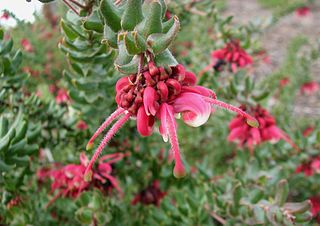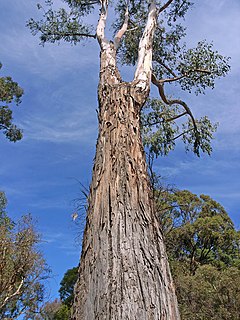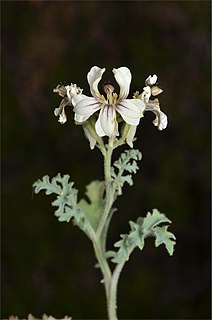
Pandorea jasminoides, also known by the common names bower of beauty and bower vine, is a species of flowering plant in the family Bignoniaceae and is endemic to eastern Australia. It is a woody climber with pinnate leaves that have three to nine egg-shaped leaflets, and white or pink trumpet-shaped flowers that are red and hairy inside. It is also grown as an ornamental.

Flindersia ifflana, commonly known as hickory ash or Cairns hickory, is a species of tree in the family Rutaceae and is native to Papua New Guinea and Queensland. It has pinnate leaves with between four and twelve egg-shaped to elliptical leaflets, panicles of white or cream-coloured flowers and woody fruit studded with rough points.

Grevillea baueri, commonly known as Bauer's grevillea, is a species of flowering plant in the family Proteaceae and is endemic to the coastal ranges of south-eastern New South Wales. It is a low, spreading to erect shrub with mostly oblong to egg-shaped leaves with red to pink and cream-coloured or yellow flowers.

Pandorea pandorana, commonly known as the wonga wonga vine or wonga-vine, is a species of flowering plant in the family Bignoniaceae and is native to Australia, Malesia and the southwestern Pacific region. It is a woody scrambler or climber with pinnate leaves, juvenile leaves differing from those of mature plants. The flowers are tubular or funnel-shaped and white with purple markings and the fruit are capsules containing winged seeds. It is easy species to germinate and is a popular garden plant. Common cultivars include the yellow-flowered P. 'Golden Showers', the white-flowered P. 'Snowbells', and the pinkish P. 'Ruby Belle'. The wood was used in making spears for woomeras in the Central and Western deserts.

Boronia muelleri, commonly known as the forest boronia or pink boroina, is a flowering plant that occurs in forest, woodland and heath in Victoria and New South Wales in Australia. It is an erect, woody shrub or small tree with pinnate leaves and up to fifteen pink to white four-petalled flowers arranged in leaf axils in spring and summer.

Flindersia australis, commonly known as crow's ash, flindosy or Australian teak, is a species of tree that is endemic to north-eastern Australia. It has pinnate leaves with between five and thirteen egg-shaped to elliptical leaflets, white to cream-coloured flowers arranged in panicles on the ends of branchlets and followed by woody capsules studded with short, rough points and containing winged seeds.

Phebalium nottii, commonly known as pink phebalium, is a species of shrub that is endemic to eastern Australia. It has branchlets with silvery scales, oblong to elliptical leaves, deep pink to mauve flowers arranged in umbels of up to six, with the stamens distinctively offset to one side of the flower.

Eucalyptus propinqua, commonly known as the grey gum or small-fruited grey gum, is a species of medium-sized to tall tree that is endemic to eastern Australia. It has smooth, mottled bark, lance-shaped to curved adult leaves that are paler on the lower surface, flower buds in groups of between seven and fifteen, white flowers and conical or hemispherical fruit.

Eucalyptus yarraensis, commonly known as Yarra gum, is a tree species that is endemic to Victoria, Australia. It has rough bark on the trunk and larger branches, lance-shaped to elliptical or egg-shaped adult leaves, flower buds in groups of seven, white flowers and conical fruit. In 2021 the Victorian Government listed it as critically endangered under the Flora and Fauna Guarantee Act.

Boronia safrolifera, commonly known as safrole boronia, is a species of flowering plant that is endemic to eastern Australia. It is an erect, woody shrub with pinnate leaves that have up to nineteen leaflets, and white to pink, four-petalled flowers.

Zanthoxylum nitidum, commonly known as shiny-leaf prickly-ash, tez-mui or liang mian zhen, is a species of flowering plant in the family Rutaceae. It is a woody climber with prickles on the branchlets, thick, cone-shaped spines on the trunk and older branches, pinnate leaves with five to nine leaflets, and panicles or racemes of white to pale yellow, male or female flowers in leaf axils and on the ends of branchlets.

Eucalyptus consideniana, commonly known as yertchuk, is a species of plant in the myrtle family and is endemic to south-eastern Australia. It is a tree with rough, fibrous, sometimes prickly bark on the trunk and larger branches, smooth grey bark above, lance-shaped or curved adult leaves, flower buds in groups of between eleven and nineteen, white flowers and conical to hemispherical fruit.

Eucalyptus dunnii, commonly known as Dunn's white gum or simply white gum, is a species of medium-sized to tall tree that is endemic to eastern Australia. It has rough bark near the base, smooth white to cream-coloured bark above, lance-shaped to curved adult leaves, flower buds in groups of seven, white flowers and cup-shaped, conical or hemispherical fruit.
Zieria robusta, commonly known as round-leafed zieria, is a plant in the citrus family Rutaceae and is endemic to eastern Australia. It is an erect, bushy shrub with leaves composed of three leaflets which are egg-shaped with the narrower end towards the base. The flowers are pink to white and arranged in groups of up to nine and have four petals and four stamens.

Boronia granitica, commonly known as granite boronia, is a plant in the citrus family, Rutaceae and is endemic to a small area of eastern Australia. It is an erect shrub with many branches, compound leaves and pink, four-petalled flowers.
Boronia citrata, commonly known as lemon boronia, is a plant in the citrus family, Rutaceae and is endemic to Victoria. It is an erect, woody shrub with pinnate, strongly lemon-scented leaves and pale pink to rosy pink, four-petalled flowers arranged in groups of up to five.

Goodenia calcarata, commonly known as streaked goodenia, is a species of flowering plant in the family Goodeniaceae and is endemic to Australia. It is an erect, annual herb with toothed egg-shaped to oblong leaves, racemes of white, cream-coloured or pink to mauve flowers with brownish markings, and oval fruit.
Goodenia atriplexifolia is a species of flowering plant in the family Goodeniaceae and is endemic to Queensland. It is a woody sub-shrub covered with woolly hairs, with elliptic to egg-shaped leaves with toothed or serrated edges, and leafy spikes of cream-coloured flowers.

Bossiaea concolor is a species of flowering plant in the family Fabaceae and is endemic to eastern Australia. It is an erect shrub with elliptic to oblong or egg-shaped leaves with the lower end towards the base, and yellow and red flowers.
Pandorea floribunda is a species of flowering plant in the family Bignoniaceae and is endemic to eastern Australia. It is similar to Pandorea pandorana but the leaflets are egg-shaped, 30–80 mm (1.2–3.1 in) long and 15–50 mm (0.59–1.97 in) wide and the flowers are pale yellow to cream-coloured.
















